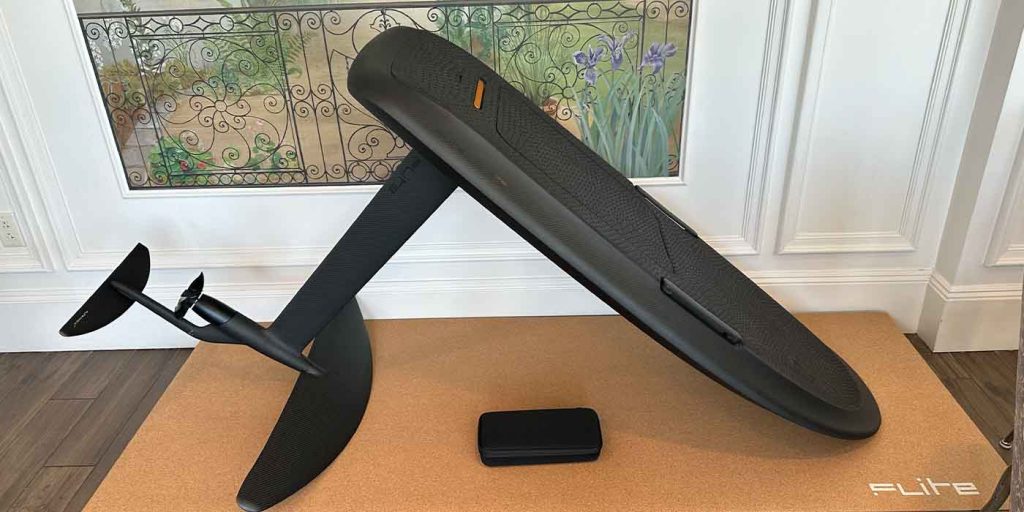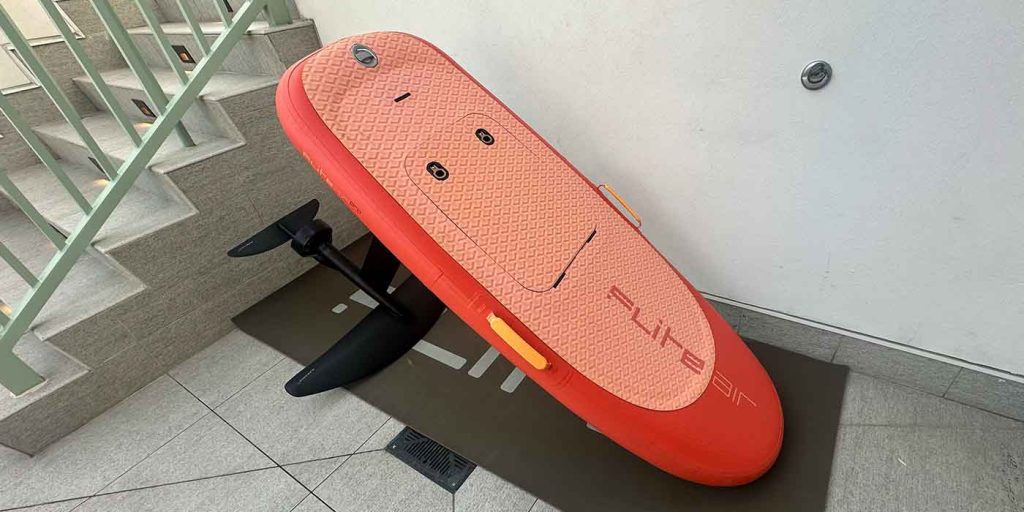I have seen the future of sustainable water sports; my friends, it is good. I recently got the chance to take Flite’s lineup of eFoils out on the waters of South Carolina, and all I can say is, “What a feeling.” Watch me hydrofoil (and fall plenty) in the video below.
Flite began and still reigns as one of the pioneers in electric hydrofoils, or “eFoils” for short. In less than six years, the Australian eFoil developer has put its brand and the young new segment in electric water sports on the global map.
When you’re creating a new form of mobility, there’s plenty of room for innovation and improvement, something I’ve admired about Flite in the years I’ve been covering it. Its ever-growing portfolio of electric hydrofoils of varying sizes and levels of rider expertise has genuinely helped grow the segment since the debut of the original Fliteboard.
In the past year and a half alone, we saw Flite launch its Series 3 lineup of eFoils, including the ULTRA L, marketed as the “world’s lightest,” the more affordable Flite AIR, and even a Flite Scooter with removable handlebars that can help get people of all skill levels involved.
While I’ve covered much of Flite’s progress, I had never gotten the opportunity to experience the sensation of “flying” above the water’s surface until recently, when some experts with the company took me out in Charleston, South Carolina, to give it a go. Here are my thoughts.
Flite eFoil boards are fun as hell if you can afford one
On the morning of our rides, I found myself slightly nervous but overall excited to test out Flite’s lineup of eFoils. I had seen them ridden by others plenty of times and always wanted to experience the technology for myself. I just wasn’t sure how good I’d be since I had only surfed once in my life and truthfully didn’t enjoy it that much.
During a crash course on the dock before taking to the sea, I learned that the art of the Flite eFoil is nothing like surfing. In fact, it’s the opposite, as your weight distribution relies heavily on the front of the board to keep the nose down instead of the rear, like in surfing.
The instructors, who were extremely helpful and knowledgeable, by the way, explained that the stance and movements are more like snowboarding—an activity I’ve been doing since I was a kid. This was music to my ears.
After learning how to prime the throttle and get the all-electric motor running, I was in the water on the classic 100L carbon Fliteboard – the original that started it all that is one beginner level up from the previously mentioned Flite AIR eFoil.
From my very first ride, I almost immediately got to my knees, learning the nuances of balancing and steering. After less than a minute, my instructor, who also happened to be a decorated water sports champion, told me to stand up. I quickly got up and began foiling, and then I quickly got down, taking a dip.
It’s all part of the learning process, and I was equipped with plenty of protection. When falling, the trick is to really embrace the spill and leap as far away from the board as possible. That’s an art form in itself, and the water provides a nice soft spot to land. You can see some of my best spills in the video below.
There’s definitely a learning curve to eFoiling, but I was surprised at just how easy it was. You may recall I once tried an electric surfboard, and I admittedly couldn’t get up on the damn thing. Flite’s eFoil’s are much easier to familiarize yourself with, and once you get the hang of it, you may just be hooked.
After a couple of runs, I learned just how subtle your leans forward and backward have to be on the eFoil to “fly,” the sensation of floating above the water cannot be over-emphasized. It’s truly a feeling of weightlessness and joy, and the lack of noise from the electric motor allows you to take in the moment cutting through the water… until you get too cocky, wobble, and get humbly ejected.
The Flite instructors soon saw me doing my thing on the eFoil, soaring up and down with control and comfort while stalling in the air at points. Due to my early talents, the Flite team decided I was ready for a smaller, lighter eFoil, the Flite Pro. I took a second to hydrate on the land (foiling can be a workout when you’re new to it), then I was back to it.
For this one, I had to put much more weight on the front end to get it hydroplaning before I could hop to my knees and eventually stand up. On my first couple of attempts, I got yeeted pretty hard off the board but quickly bounced back for more and eventually tamed the stark white aquatic dragon.
Overall, I spent well over an hour on the water and had plenty of battery life left across the two Flite boards I tested. The company sells three Flitecell battery packs that can be swapped out, offering varying operating times between 45 minutes and two hours, depending on your size, weight, and eFoil.
Overall, I had an amazing time testing the eFoils from Flite and would recommend them to anyone as a fun and innovative new way to get around on the water. The Flite AIR is currently your most affordable option, but it still starts at $7,000, so it is not cheap. From there, prices can go well over $15,000 for the “Ultra” professional-level boards, but if you have the money for a yacht, this would be an excellent toy to bring aboard.
If you can’t afford a Flite eFoil, I recommend checking to see if there’s a Flite school near you where you can rent one and get hands-on training from professionals like I did. Hydrofoiling is an amazing sensation you’ve got to try, and I’m debating getting one for myself to cruise around Lake Michigan.
Who knows, maybe I’ll go pro. Hey, it could happen!
Want to see me eat salt water? Check out the full video of the Flite eFoil experience below:
FTC: We use income earning auto affiliate links. More.

![First ride on the Flite eFoils: Easy to learn and outrageous ‘flying’ fun out on the water [Video] First ride on the Flite eFoils: Easy to learn and outrageous ‘flying’ fun out on the water [Video]](https://i0.wp.com/electrek.co/wp-content/uploads/sites/3/2024/06/Flite-eFoil-review.jpg?resize=1200,628&quality=82&strip=all&ssl=1)




